Mountain biking is an exhilarating outdoor activity that allows riders to immerse themselves in rugged landscapes and conquer challenging trails. Whether you’re an experienced mountain biker or a beginner, this ultimate guide is here to provide you with essential tips, trail advice, and gear reviews to elevate your next off-road adventure. From selecting the perfect mountain bike to mastering riding techniques, we’ll cover everything you need to know to make the most of your mountain biking experiences.
Key Takeaways:
- Explore breathtaking mountain biking trails that take you through stunning landscapes.
- Master various riding techniques to navigate challenging terrains with confidence.
- Choose the right mountain bike that suits your riding style and preferences.
- Discover different styles of mountain biking, from cross-country to downhill and enduro.
- Embrace the adrenaline rush of gravity-assisted descents and the endurance required for long-distance rides.
Exploring the Different Styles of Mountain Biking
Mountain biking encompasses various styles and disciplines, each offering unique challenges and experiences. Whether you love the adrenaline rush of downhill descents or the endurance required for cross-country riding, there’s a style of mountain biking that suits every rider’s preferences. Let’s dive into each style, exploring their distinctive features and characteristics.
Downhill Biking: Embracing Gravity’s Thrill
Downhill biking is a gravity-assisted style that focuses on exhilarating descents. It involves riding at high speeds down steep and technical trails, encountering jumps, drops, and berms along the way. Downhill bikers seek the thrill of conquering challenging terrains while relying on their skills and reflexes. It is often practiced in designated bike parks and purpose-built downhill trails.
Cross-Country Riding: Endurance and Skill
Cross-country (XC) riding is all about endurance and skill. It involves traversing long distances over varied terrains, including singletrack, double-track, and dirt roads. Cross-country riders face the challenge of long climbs and technical descents, emphasizing both physical fitness and technical capabilities. XC bikes are lightweight, often equipped with efficient suspension systems, and built for speed.
All Mountain: A Blend of XC and DH
All mountain biking combines elements of both cross-country and downhill riding. It offers a more aggressive and challenging experience compared to XC, while still valuing endurance. All mountain riders tackle larger obstacles, rougher trails, and steeper descents, pushing their skills to the limit. All mountain bikes have full suspension and more robust frames, capable of handling technical terrain.
Enduro: The Ultimate Test of Versatility
Enduro mountain biking is a discipline that tests riders’ versatility. It brings together elements of downhill, cross-country, and all mountain riding. Enduro races typically consist of multiple timed downhill sections with uphill transitions between them. Riders need a balance of endurance, technical skill, and speed to excel in this demanding style. Enduro bikes are built to handle challenging terrain, with longer suspension travel and a focus on efficiency.
eMTB Adventures: Unlocking New Possibilities
The rise of electric mountain bikes, or eMTBs, has revolutionized the sport. eMTBs are equipped with battery-powered motors that assist with pedaling, making it easier to tackle challenging terrains and climb steep hills. These bikes extend the range and capabilities of riders, enabling them to explore more challenging trails and embark on longer adventures. eMTBs offer a thrilling experience while catering to riders of various skill levels and physical abilities.
Comparison of Mountain Biking Styles
| Style | Main Focus | Features | Key Destinations |
|---|---|---|---|
| Downhill Biking | Gravity-assisted descents | High-speed descents, technical trails, bike parks | Whistler Bike Park (Canada), Leogang Bike Park (Austria), Trestle Bike Park (Colorado) |
| Cross-Country Riding | Endurance and skill | Long-distance riding, varied terrain, speed-oriented | Bentonville (Arkansas), Bend (Oregon), Park City (Utah) |
| All Mountain | Aggressive and challenging riding | Obstacle navigation, rough trails, versatile bikes | Whistler (British Columbia), Jura mountains (Switzerland), Black Forests (Germany) |
| Enduro | Technical skill and endurance | Timed downhill sections, uphill transitions, efficient bikes | Moab (Utah), Whistler (British Columbia), Dolomites (Italy) |
| eMTB Adventures | Extended explorations | Battery-powered assistance, challenging terrains, extended range | Various locations worldwide |
“Mountain biking encompasses various styles and disciplines, each offering unique challenges and experiences.”
As you can see, mountain biking offers diverse styles catering to different preferences and skill levels. Whether you enjoy the thrill of downhill descents, the endurance required for cross-country riding, the versatility of all mountain biking, the technical challenges of enduro, or the extended adventures of eMTBs, there’s a style that suits you. So, get ready to hit the trails, challenge yourself, and experience the exhilaration of mountain biking!
Cross-Country Riding: For Those Who Pedal

Cross-country riding is a style of mountain biking that showcases endurance and skill. It involves riding on singletrack, double-track, and dirt roads while pedaling under your own power. Cross-country riders enjoy the thrill of covering long distances and conquering varied terrains.
XC bikes, also known as cross-country bikes, are specifically designed for efficiency and lightweight performance. They feature lockable suspension and utilize lightweight 29″ wheels, which enhance speed and maneuverability on the trails. With their agile nature, XC bikes enable riders to navigate technical sections and steep climbs with ease.
Benefits of Cross-Country Riding
- Endurance Building: Cross-country riding is an excellent way to build endurance as it requires sustained effort over long distances and varying terrains.
- Scenic Trail Exploration: With its focus on covering diverse landscapes, cross-country riding allows bikers to discover breathtaking trails and immerse themselves in nature.
- Full Body Workout: Pedaling uphill and navigating technical descents engages multiple muscle groups, providing a complete workout for the body.
- Adventure and Freedom: Cross-country riding offers a sense of adventure and freedom as riders explore new destinations and venture into uncharted territories.
Embarking on a cross-country biking adventure opens doors to breathtaking scenery and memorable experiences. Some popular cross-country riding destinations include Bentonville, Arkansas, renowned for its extensive trail system, Bend, Oregon, offering diverse cross-country routes, and Park City, Utah, with its stunning mountain vistas and expansive trail networks.
DH Mountain Bikes: Embracing Gravity
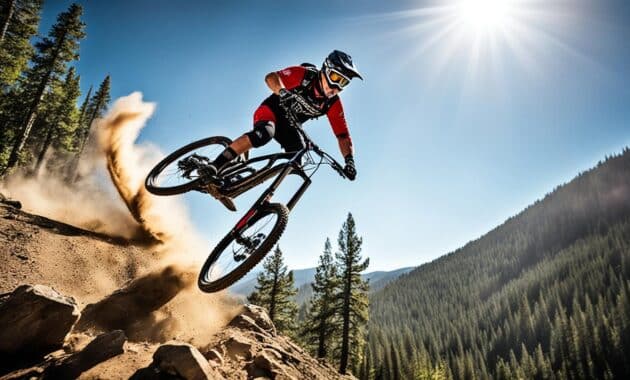
Downhill mountain biking is an exhilarating sport that allows riders to fully embrace gravity and experience adrenaline-pumping descents. Unlike other styles of mountain biking, downhill riding takes place in bike parks or specially designed trails that eliminate the need to cycle uphill.
Downhill (DH) bikes are specifically engineered for the demands of this extreme sport. They are equipped with front and rear suspension systems that provide significant travel, allowing riders to tackle rough terrains with ease. DH bikes also feature powerful brakes for precise control and sturdy frames that can withstand the impact of aggressive descents and jumps.
One of the distinguishing features of downhill mountain biking is the graded difficulty of the trails. This ensures that riders of all skill levels can enjoy the sport, from beginners looking for a thrilling introduction to advanced riders seeking the ultimate challenge.
Ready to get your adrenaline pumping? Check out these popular destinations for downhill mountain biking:
- Whistler Bike Park, Canada
- Leogang Bike Park, Austria
- Trestle Bike Park, Colorado
These bike parks offer a wide range of trails with varying levels of difficulty, ensuring there’s something for everyone, whether you’re a seasoned downhill rider or a newcomer to the sport.
All Mountain: Where XC Meets DH Intensity
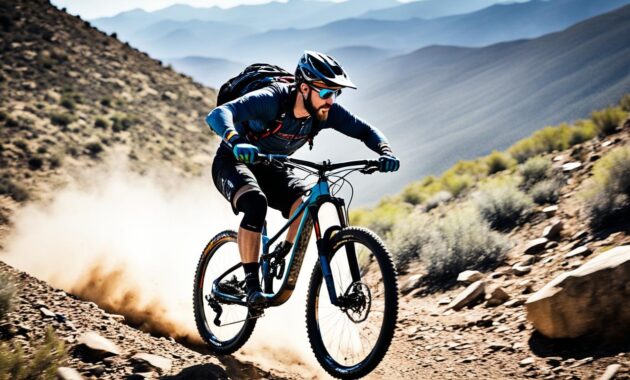
All mountain biking combines elements of cross-country (XC) and downhill (DH) riding, offering a more aggressive and challenging experience. AM riders thrive on pushing the boundaries of their skills, navigating larger obstacles, and conquering rougher trails.
All mountain bikes, commonly referred to as AM bikes, are specifically designed for this style of riding. They are sturdier and more robust than XC bikes, equipped with full suspension and travel between 140-160 mm, providing better control and comfort on challenging terrain.
What sets all mountain biking apart is how it seamlessly blends the characteristics of XC and DH. Riders can enjoy the thrills of downhill descents while also taking on the endurance-demanding climbs typical of XC riding. This combination allows for a more aggressive approach to mountain biking while still valuing the importance of endurance.
All mountain biking has gained popularity across the globe, with many renowned destinations offering a variety of challenging trails that cater to AM enthusiasts. Let’s take a look at some popular all mountain biking destinations:
- Whistler – British Columbia, Canada: Known for its vast trail network, Whistler offers all mountain riders a diverse range of challenging trails set in breathtaking mountain scenery.
- Jura mountains – Switzerland: The Jura mountains boast rugged terrain and a vast trail network, providing AM riders with thrilling descents and technical challenges.
- Black Forests – Germany: Famous for its dense forests and rolling hills, the Black Forests offer all mountain bikers an exciting mix of flowing singletrack and technical descents.
If you’re seeking a mountain biking experience that combines the best elements of XC and DH, all mountain biking is the perfect choice. Strap on your helmet, unleash your adventurous spirit, and conquer those aggressive and challenging trails!
Enduro: New Era of Climbing and Descending
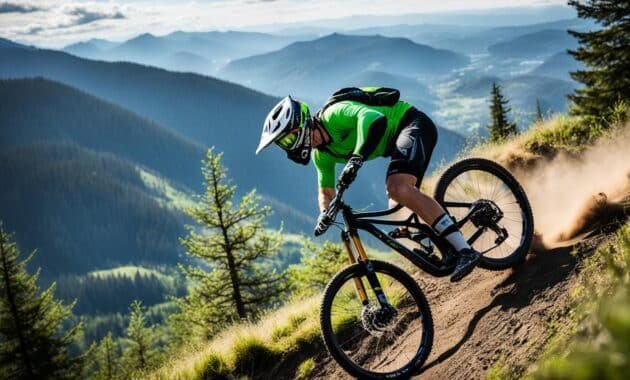
Enduro mountain biking is a thrilling discipline that combines the adrenaline of downhill racing with the endurance and technical challenges of cross-country and all mountain riding. Originally developed as a competitive format, enduro has gained immense popularity among riders of all skill levels.
This exciting style of mountain biking features timed downhill sections that are preceded by demanding uphill climbs. It requires a delicate balance of endurance, technical skill, and speed. Enduro enthusiasts embrace the physical and mental challenges presented by both climbing and descending, making it a truly exhilarating experience.
Enduro bikes have full suspension systems with travel ranging from 140-170 mm, providing the necessary support and control for tackling varied terrains. These bikes are designed to handle the demanding nature of uphill climbs while still delivering the thrill of high-speed descents.
Enduro riding has significantly influenced the development of trails, equipment, and clothing. Purpose-built enduro trails showcase technical features such as rock gardens, drops, and berms, providing an exciting and challenging experience for riders. Enduro-specific gear and apparel are designed to enhance performance and provide protection during intense rides.
Popular destinations for enduro mountain biking include the iconic trails of Moab in Utah, the world-class trails of Whistler in British Columbia, and the breathtaking Dolomites in Italy. These locations offer diverse terrain, stunning scenery, and a variety of trails suitable for different skill levels.
So, strap on your helmet, hop on your enduro bike, and experience the thrill of this new era of climbing and descending on the trails. Whether you’re a seasoned racer or a passionate rider seeking a new challenge, enduro mountain biking will push your limits and provide an unforgettable adventure.
| Key Features of Enduro Mountain Biking | Benefits of Enduro Mountain Biking |
|---|---|
|
|
Powering the Future: Unleashing the Potential of eMTB Adventures
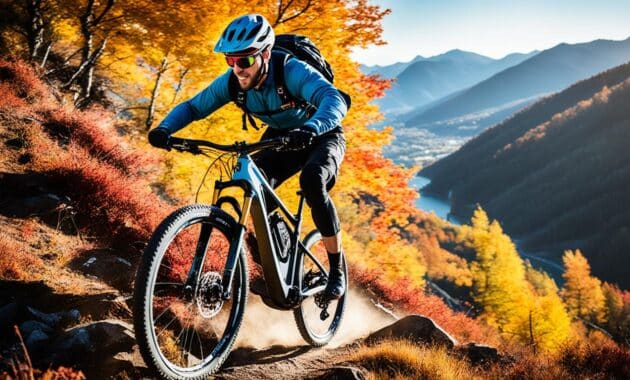
Electric mountain bikes, also known as eMTBs, are revolutionizing the world of mountain biking. With their battery-powered motors, eMTBs are changing the game by making challenging terrains more accessible and extending adventures for riders of all skill levels.
eMTBs provide an added boost of power that assists with pedaling, allowing riders to conquer steep hills and navigate rugged landscapes with ease. These electric mountain bikes are especially popular among riders seeking extended adventures and those who may have physical limitations.
Imagine covering greater distances, climbing steeper inclines, and exploring challenging trails without being limited by your own physical capabilities. eMTBs make it possible to push boundaries and experience the thrill of conquering even the most demanding terrains.
Whether you’re embarking on an epic mountain biking journey or simply looking to amplify your riding experience, eMTBs offer a new level of exploration and excitement. These electric-powered bikes have opened up new possibilities and are powering a new era of mountain biking exploration.
Essential Gear and Equipment
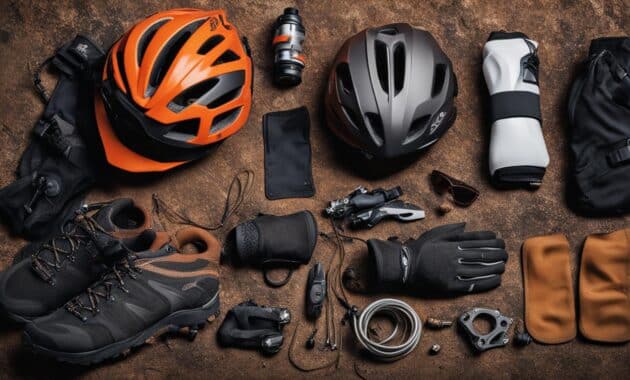
Before hitting the trails, it’s essential to have the right gear and equipment. This section will cover the essential safety gear, mountain bike types, and biking apparel that will enhance your mountain biking adventures.
Safety Gear
When it comes to mountain biking, safety should be your top priority. Wearing the proper safety gear can protect you from injuries and ensure a safer riding experience. Here are some essential safety gear items:
- Helmets: A well-fitting helmet is a must-have for every mountain biker. It protects your head from potential impacts and reduces the risk of head injuries. Look for helmets that meet safety standards and provide proper ventilation for comfort.
- Gloves: Mountain biking gloves offer grip, protection, and comfort. They help prevent blisters, provide extra padding for your hands, and protect against cuts and scrapes during falls or encounters with branches.
- Protective Gear: Depending on the level of difficulty and intensity of your mountain biking trails, you may consider additional protective gear like knee pads, elbow pads, and body armor. These items provide extra protection for your joints and critical areas.
Mountain Bike Types
Choosing the right mountain bike type is crucial for maximizing your riding performance and enjoyment. Different types of mountain bikes excel in specific terrains and riding styles. Here are some common mountain bike types:
- Cross-Country Bikes: These bikes are designed for speed and endurance on long, varied terrains. They are lightweight and efficient, making them ideal for XC racing and long-distance riding.
- Trail Bikes: Trail bikes strike a balance between climbing and descending capabilities. They offer versatility for tackling a wide range of trail conditions, making them a popular choice for most riders.
- Downhill Bikes: Built for speed and stability on steep and rough downhill trails, downhill bikes feature long-travel suspension, strong brakes, and sturdy frames to handle aggressive descents and jumps.
- All-Mountain/Enduro Bikes: All-mountain or enduro bikes are designed to handle challenging terrain, combining the climbing ability of XC bikes with the descending capabilities of downhill bikes. They are versatile and suitable for riders who want to explore a variety of terrains and tackle technical trails.
- eMTBs: Electric mountain bikes, or eMTBs, are equipped with a battery-powered motor that assists with pedaling. They are perfect for riders who want to tackle challenging terrains or go on extended adventures with ease.
Biking Apparel
Proper biking apparel not only keeps you comfortable but also maximizes your performance on the trails. Here are some essential biking apparel items:
- Jerseys: Biking jerseys are designed to wick away moisture, keeping you cool and dry during rides. Look for jerseys with breathable fabrics and features like zippered pockets for storing small essentials.
- Shorts: Mountain bike shorts provide comfort and protection. They usually come with padding or removable liners for added cushioning during long rides.
- Shoes: Invest in a pair of mountain biking shoes with proper grip and stiffness. These shoes enhance your connection to the pedals and provide protection for your feet.
With the right safety gear, mountain bike type, and biking apparel, you’ll be well-prepared for your mountain biking adventures. Remember to prioritize safety, choose gear suitable for your riding style, and enjoy the thrill of conquering the trails!
Also Read : Unveil The Fastest Bike In The World Today!
Conclusion
Mountain biking is more than just a physical activity; it is a transformative journey through nature that brings numerous benefits for both the body and the mind. By venturing into the great outdoors on a mountain bike, riders have the opportunity to explore and marvel at the beauty of natural landscapes, while simultaneously challenging themselves physically and mentally.
One of the key attractions of mountain biking is the unique thrill of conquering trails of all types. From the heart-pounding adrenaline rush of downhill descents to the endurance and stamina required for cross-country rides, mountain biking offers a diverse range of experiences that cater to the individual preferences of riders. No matter the style or intensity, the sense of achievement and personal growth that comes from successfully navigating challenging terrain is unparalleled.
Aside from the excitement of the sport itself, mountain biking also delivers a wide range of physical and mental fitness benefits. The rigorous physical demands of navigating uneven surfaces, powering through climbs, and maintaining control on technical descents contribute to overall strength, cardiovascular fitness, and improved balance. Moreover, spending time in nature has been shown to have positive effects on mental well-being, helping to reduce stress, enhance mood, and promote a sense of overall tranquility.
As you embark on your mountain biking adventures, it’s important to prioritize safety by wearing appropriate protective gear, selecting the right bike for your chosen style, and adhering to trail etiquette. By doing so, you can fully immerse yourself in the incredible world of mountain biking, taking advantage of the benefits it brings while exploring majestic natural surroundings. So, saddle up, embrace the trails, and experience the joy of mountain biking firsthand.
FAQs
Q: What are some essential mountain biking gear I should have?
A: Essential mountain biking gear includes a helmet, gloves, appropriate clothing, a well-maintained mountain bike, tools for basic repairs, and a hydration pack.
Q: What are the different types of mountain biking trails?
A: Mountain biking trails can be categorized as singletrack trails, fire roads, downhill trails, cross country trails, and man-made trails with various features and difficulty levels.
Q: How do I choose the best mountain biking trail for my skill level?
A: Consider factors like trail difficulty, length, elevation gain, and technical features to find a trail that matches your skill level and fitness. Research trail reviews and speak to local riders for recommendations.
Q: Where can I find the best mountain biking trails?
A: The best mountain biking trails can be found in mountain biking capitals, national parks, ski resorts, and forested areas with well-maintained trail networks. Websites and apps like Trailforks and MTB Project are useful resources for finding trails.
Q: What are some tips for beginners getting into mountain biking?
A: Beginners should start with easy, well-marked trails, take a skills clinic, learn bike handling skills, and gradually progress to more challenging trails as their skills improve. It’s also important to ride with experienced mountain bikers who can offer guidance.
Q: What is a full suspension mountain bike and why is it beneficial?
A: A full suspension mountain bike has both front and rear suspension to absorb shocks and impacts, providing a smoother ride on rough terrain. This can improve comfort, control, and traction on the trail.
Q: What are some popular coast mountain biking destinations?
A: Popular coast mountain biking destinations include the Pacific Northwest, British Columbia, Oregon, and Washington, known for their scenic coastal trails and diverse terrain for mountain biking.
Q: What are some advanced mountain biking experiences for experienced riders?
A: Advanced mountain biking experiences include tackling steep downhill descents, navigating technical rock gardens and rooty sections, riding narrow singletrack trails with exposure, and exploring challenging backcountry trails.
Q: What should I do if I encounter new trail features while mountain biking?
A: Approach new trail features cautiously, assess them for safety, and consider walking or scouting them first to understand the best line and technique to navigate them safely.
Q: How can I contribute to preserving mountain biking trails and access?
A: You can contribute to preserving mountain biking trails and access by following trail etiquette, participating in trail maintenance and volunteer efforts, supporting local trail organizations, and advocating for responsible land use and trail access.
Source Links
- https://www.ridebig.com/mountain-bike-stories/types-of-mountain-biking-trips
- https://www.utahmapstore.com/collections/mountain-biking-books
- https://magicshine.com/blogs/cycling-tips/how-to-start-mountain-biking-your-ultimate-guide-to-starting-strong
